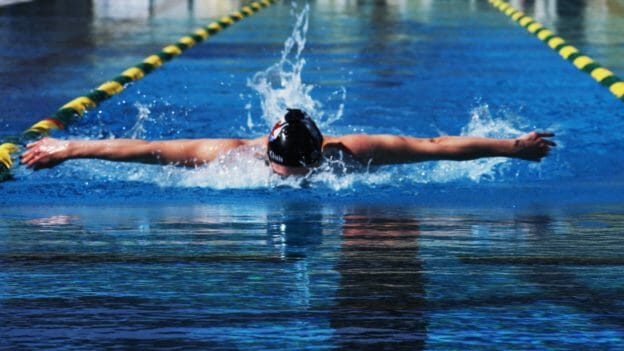An Unclear Fit
A short-axis stroke is defined as a stroke where there is desirable rotation of the body along the short axis through the middle of the hip, as opposed to the long axis, along the length of the body. Breaststroke is a short-axis stroke because the swimmer should extend the lower lumbar spine (arch the back) and elevate the shoulders as much as possible to augment the force of the kick. Breaststroke does not rotate the body on the short axis, but it does bend the body on the short axis. It can do that because the body’s speed in breaststroke, before the kick, goes to nearly zero. Freestyle and backstroke are both long-axis strokes as there is clearly body rotation around the axis in the line of motion down the pool with each. What about butterfly? Where does it fit in?
Butterfly is clearly not a long-axis stroke, but it is not really a short axis stroke, either. Because the body speed in fly should never approach zero, a swimmer should neither bend nor rotate much on the short axis. The body needs to stay in a more horizontal position to reduce frontal drag. In order to maximize propulsion from the dolphin kick, however, there has to be some undulation at the hip. So the body cannot remain perfectly horizontal either.
What is a Short-Axis Stroke?
Unlike breaststroke, where the kinetic energy of the upper body and head moving angularly forward and downward couples with the kick, augmenting its force, the underwater pull and first down kick of butterfly occur as the upper body and head elevate for the breath, not moving downward, so there is no coupling energy there. While the downward motion of the upper body and head in fly and the forward swinging of the recovering arms might couple with the second down kick, over elevating the body will cause too much drag to benefit the over all speed.
In breaststroke, the elevation of the shoulders occurs during the underwater pull and before the next kick. In other words, it is a period of deceleration when the body’s speed is slowing and comes nearly to a halt, once the knees are brought forward under the body for the next kick. Since frontal drag is exponentially related to the velocity, putting the body in this poor shape (for frontal drag) during this slow time has less adverse effect than if the body were traveling fast.
In butterfly swimming, the body never stops moving and there are typically two peak velocity points. The first occurs on the first down kick, when the hands are underwater pulling. If a breath is taken on this stroke, then the additional shoulder elevation can adversely affect this peak velocity. The second peak velocity occurs on the second down kick which should occur simultaneously with the entry of the recovering arms into the water.
Hydroplane
In order to get the head above water for the breath and because the preceding up kick requires some extension of the lumbar spine, there will always be some shoulder elevation for the breath and curvature of the body. However, the shoulder elevation can be minimized by allowing the neck to extend forward as much as possible.
Indeed, when watching Michael Phelps take a breath, that is precisely what happens. It is as if he were a giraffe, extending his long neck forward, yet low to the water, to get each breath. By doing so, he minimizes the elevation of the shoulder. With the strong kick, he elevates the entire body to remain flatter and skates over the top of the water. That is the closest we may ever see a human being come to hydroplaning.
In butterfly, use your neck muscles to breathe forward, not upward, develop a strong kick and skate over the top of the water for maximum speed and distance per stroke.
Yours in swimming,
Gary Sr.

